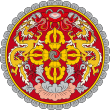| English: The Thunder Dragon Kingdom | |
|---|---|
| འབྲུག་ཙན་དན་ | |
 | |
National anthem of | |
| Lyrics | Dorji Lopen Droep Namgay Dasho Gyaldun Thinley |
| Music | Aku Tongmi |
| Adopted | 1953 |
| Audio sample | |
"Druk Tsenden" (Dzongkha: འབྲུག་ཙན་དན, Dzongkha pronunciation: [ɖ(ʐ)ṳ̀e̯ t͡sén.d̥è̤n]; "The Thunder Dragon Kingdom") is the national anthem of Bhutan. Adopted in 1953, the lyrics were written by Dolop Droep Namgay and possibly translated into English by Dasho Gyaldun Thinley. The accompanying music was composed by Aku Tongmi.
History
Despite claims made in Brozović's Enciklopedija (1999) and many subsequent authors, who attribute the authorship of the national anthem to Gyaldun Thinley, father of the former Prime Minister Jigme Thinley, there are many who believe that the words and the national anthem itself were penned by Dorji Lopen Dolop Droep Namgay of Talo, Punakha. The Dorji Lopen is the most senior of the four senior Lopens in Bhutan's religious establishment, and often serves as the Deputy Je Khenpo. Dolop Droep Namgay maintained close personal and working relations with the third King of Bhutan, Jigme Dorji Wangchuck, during whose reign Gyaldun Thinley served in various capacities.
It is possible that Gyaldun Thinley may have been involved in working closely with Dolop Droep Namgay and translating the lyrics into English. It is also highly likely that he (and/or his son Jigme Thinley who served in many important government and political capacities since the 1990s) was one of the persons of first contact for Dalibor Brozović who attributed Gyaldun Thinley as the author of the lyrics; however, many regard Dolop Droep Namgay as the author.
Aku Tongmi was educated in Shillong, India and had recently been appointed leader of the military brass band when the need for an anthem rose at the occasion of a state visit from the Indian Prime Minister Jawaharlal Nehru. His original score was inspired by the Bhutanese folk tune "The Unchanging Lotus Throne" (Thri nyampa med pa pemai thri). The melody has twice undergone changes by Tongmi's successors as band leaders. The original lyrics were 12 lines, but were shortened to the present six-line version in 1964 by a secretary to the king.
As the anthem is inspired by a folk tune, there is a choreography to it as well, originally directed by Tongmi.
In 1953, His majesty the king Jigme Dorji Wangchuk ordered to compose a national anthem for Bhutan. So, the lyrics, choreography and tune were then composed taking the national anthem of England and India as a references.
Lyrics
The lyrics to the national anthem are inscribed in the Constitution of Bhutan.
| Dzongkha original | Official romanization | IPA transcription | Official English translation |
|---|---|---|---|
|
འབྲུག་ཙན་དན་བཀོད་པའི་རྒྱལ་ཁབ་ནང་༎ |
Dru tsend°en kepä gäkhap na |
|
In the Kingdom of Bhutan adorned with cypress trees, |
See also
Notes
- The official Dzongkha romanization endorsed by the Constitution of Bhutan, devised by Dr. George van Driem.
- See Help:IPA and Dzongkha § Phonology.
References
- Brozović, Dalibor (1999). Hrvatska Enciklopedija. Vol. 1. Miroslav Krleža. p. 569. ISBN 953-6036-29-0. Retrieved 2011-10-29.
- Kinga, Sonam, ed. (2002). Globalization: the argument of our time: discussion papers. Discussion papers series 2 (1. ed.). Thimphu, Bhutan: Centre for Bhutan Studies. ISBN 978-99936-14-01-2.
- ^ Penjore, Dorji; Kinga, Sonam (2002). The Origin and Description of The National Flag and National Anthem of The Kingdom of Bhutan (PDF). Thimphu: The Centre for Bhutan Studies. p. 14. ISBN 99936-14-01-7. Archived from the original (PDF) on 2011-07-23. Retrieved 2011-04-19.
- Blackwell, Amy Hackney (2009). Independence Days: Holidays and Celebrations. Infobase Publishing. p. 15. ISBN 978-1-60413-101-7. Retrieved 2011-10-29.
- Kinga, Sonam, ed. (2002). Globalization: the argument of our time: discussion papers. Discussion papers series 2 (1. ed.). Thimphu, Bhutan: Centre for Bhutan Studies. ISBN 978-99936-14-01-2.
- "Bhutan: The Constitution of the Kingdom of Bhutan". www.wipo.int. Retrieved 2018-10-27.
- "National Anthem". Bhutan Portal. Government of Bhutan. Archived from the original on 2012-02-09. Retrieved 2011-10-29.
- van Driem, George (1991). "Guide to Official Dzongkha Romanization" (PDF). Dzongkha Development Commission, Royal Government of Bhutan. Archived from the original on February 28, 2017.
- "Constitution of Bhutan" (PDF). Archived from the original (PDF) on 5 September 2014. Retrieved 18 October 2014.
Further reading
- Minahan, James (2009). The Complete Guide to National Symbols and Emblems. Vol. 1. Greenwood Press. p. 20. ISBN 978-0-313-34498-5. Retrieved 2011-10-29.
External links
- Druk tsendhen - Audio of the national anthem of Bhutan, with information and lyrics
- National anthems.net midi file
- Dookola Swiata - This travel website has an instrumental version of the Anthem, as an .asx file.
- Children sing the anthem - This website has a sound file of Bhutanese children singing the Anthem without musical accompaniment.
- Dragon King of Bhutan calls-on President of the Republic of India on the eve of 63rd Republic Day - The anthem starts at 01:30. Rendition by Rashtrapati AngRakshak.
| Anthems of Asia | |||||||||||||||||||
|---|---|---|---|---|---|---|---|---|---|---|---|---|---|---|---|---|---|---|---|
| National |
| ||||||||||||||||||
| States with limited recognition | |||||||||||||||||||
| Regional |
| ||||||||||||||||||
| In exile/ disputed | |||||||||||||||||||
| Organisations | |||||||||||||||||||
| Former |
| ||||||||||||||||||
| Bhutan articles | |||||
|---|---|---|---|---|---|
| History |  | ||||
| Geography |
| ||||
| Politics | |||||
| Economy | |||||
| Culture |
| ||||